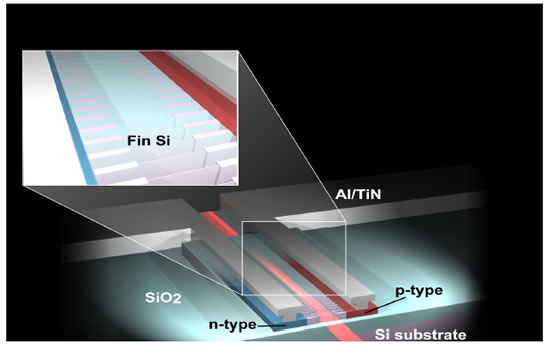Information contained in this news release is current as of the date of the press announcement, but may be subject to change without prior notice.
September 21, 2010
-- Opening The Way to Realizing a Silicon Laser Diode --
Tokyo, September 21, 2010 --- Hitachi, Ltd. (NYSE: HIT/TSE: 6501, hereafter, Hitachi) today announced the development of a silicon-fin light-emitting diode with over a thousand ultra-thin silicon films (quantum wells*1) formed perpendicularly to the silicon substrate and observation of an optical gain*2-namely, one of the conditions for laser oscillation of a diode, as part of Hitachi's challenge to achieve a practical silicon laser diode. Hitachi observed the silicon light-emission phenomenon in 2006 and the optical-amplification phenomenon in 2008, using a silicon device with a single-quantum-well structure. The present observation of optical gain in a device using fin structures is the first time demonstration of the effect of multiple quantum wells for increasing silicon luminescence up to a practical level. In addition, the developed silicon-fin light-emitting diode is suitable for mass production. It is expected that achieving larger optical gain will open the way to creating a silicon laser diode.
A part of this research is supported by the Japan Society for the Promotion of Science (JSPS) through its “Funding Program for World-Leading Innovative R&D on Science and Technology (FIRST Program; Professor ARAKAWA Yasuhiko, University of Tokyo)” and was conducted at the Institute for Photonics-Electronics Convergence System Technology (PECST).
Silicon is widely used in semiconductor materials. With the realization of a silicon laser diode, data transfer in and between semiconductor chips which are currently conducted with electrical signals, can be replaced by high-speed and low-loss optical transmission. As a result, breakthroughs in performance and power conservation in servers and IT devices can be expected. However, it is difficult to make silicon itself emit light due to property of its material. On the other hand, nanostructured silicon can emit light due to quantum effects*3.
Since 2006, Hitachi has been studying a silicon light-emitting diode which emits light itself by injecting a current into a silicon thin film only a few nanometers thick. Using an ultra-thin silicon light-emitting diode combining a single-quantum-well (SQW) structure in an optical resonator, Hitachi first observed an optical gain in 2008. These observation results were then theoretically verified by quantum-mechanics simulation in 2009. If optical gain is increased and a coherent-light is emitted, laser oscillation of silicon can be generated. A device with a conventional SQW structure is, however, insufficient to produce optical gain; therefore, for high luminescent efficiency, it is necessary to form multiple-quantum-well (MQW) structures evenly aligned with the SQW structure in an optical resonator.
In response to this need, Hitachi has developed a silicon-fin light-emitting diode with thousands of ultra-thin silicon films formed perpendicularly to the silicon substrate to fabricate MQW structures. The developed silicon-fin light-emitting diode has more than 1000 fins, which are integrated on mass using lithography*4and dry etching*5.Though the fin width is 20 nanometers just after a dry etching, the width of an oxidized fin is finally thinned down to about one nanometer. In addition, by fabricating an optical waveguide made of a silicon-nitride film on the fabricated silicon fin, it is possible to confine the light emitted from the silicon fin light-emitting diode inside an optical waveguide, thereby attaining high luminescent efficiency.
Operational verification of the developed silicon-fin light-emitting diode confirmed as light is emitted on injecting a current, propagates inside the waveguide, and is radiated from the waveguide edge. In addition, detailed luminescence-spectrum analysis confirmed the optical gain. The developed silicon-fin light-emitting diode is highly compatible with the original fin field-effect-transistor (FinFET), one of the candidates for next-generation transistors, developed by Hitachi. In addition, since the developed silicon-fin light-emitting diode is easy to integrate on a substrate, it is suitable for mass production. Accordingly, when an optoelectronic convergence chip integrating both the silicon-fin light-emitting diode and an FET on a silicon substrate is fabricated, the silicon-fin light-emitting diode can be expected to contribute to developing small-sized, high-performance, low-power servers and IT devices. From now on, Hitachi will push ahead with the research and development to realize a silicon laser diode, which will be a key technology for the future information & telecommunication systems business. These results will be presented on 23rd September 2010 at the International Conference on Solid State Devices and Materials, which will be held from the 22nd to 24th September 2010 at the Hongo Campus of the University of Tokyo, Tokyo, Japan.

Hitachi, Ltd., (NYSE:HIT / TSE:6501), headquartered in Tokyo, Japan, is a leading global electronics company with approximately 360,000 employees worldwide. Fiscal 2009 (ended March 31, 2010) consolidated revenues totaled 8,968 billion yen ($96.4 billion). Hitachi will focus more than ever on the Social Innovation Business, which includes information and telecommunication systems, power systems, environmental, industrial and transportation systems, and social and urban systems, as well as the sophisticated materials and key devices that support them. For more information on Hitachi, please visit the company's website at http://www.hitachi.com.